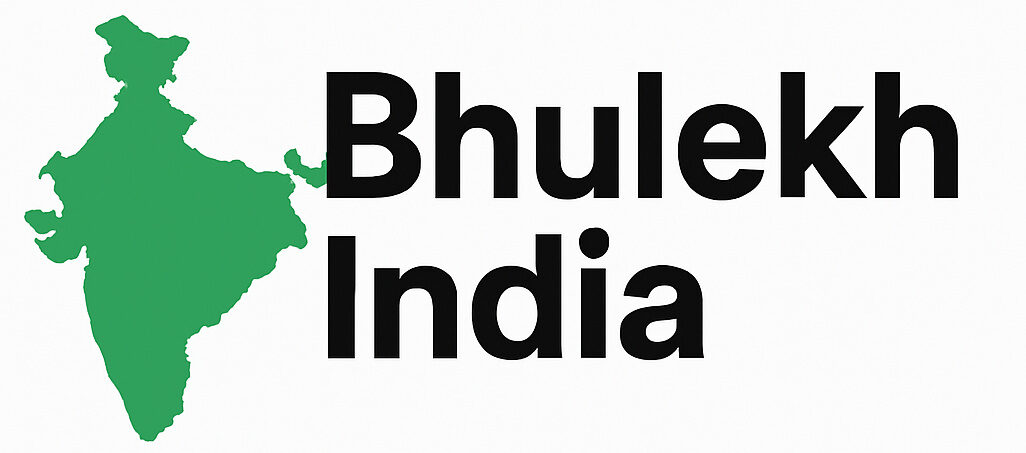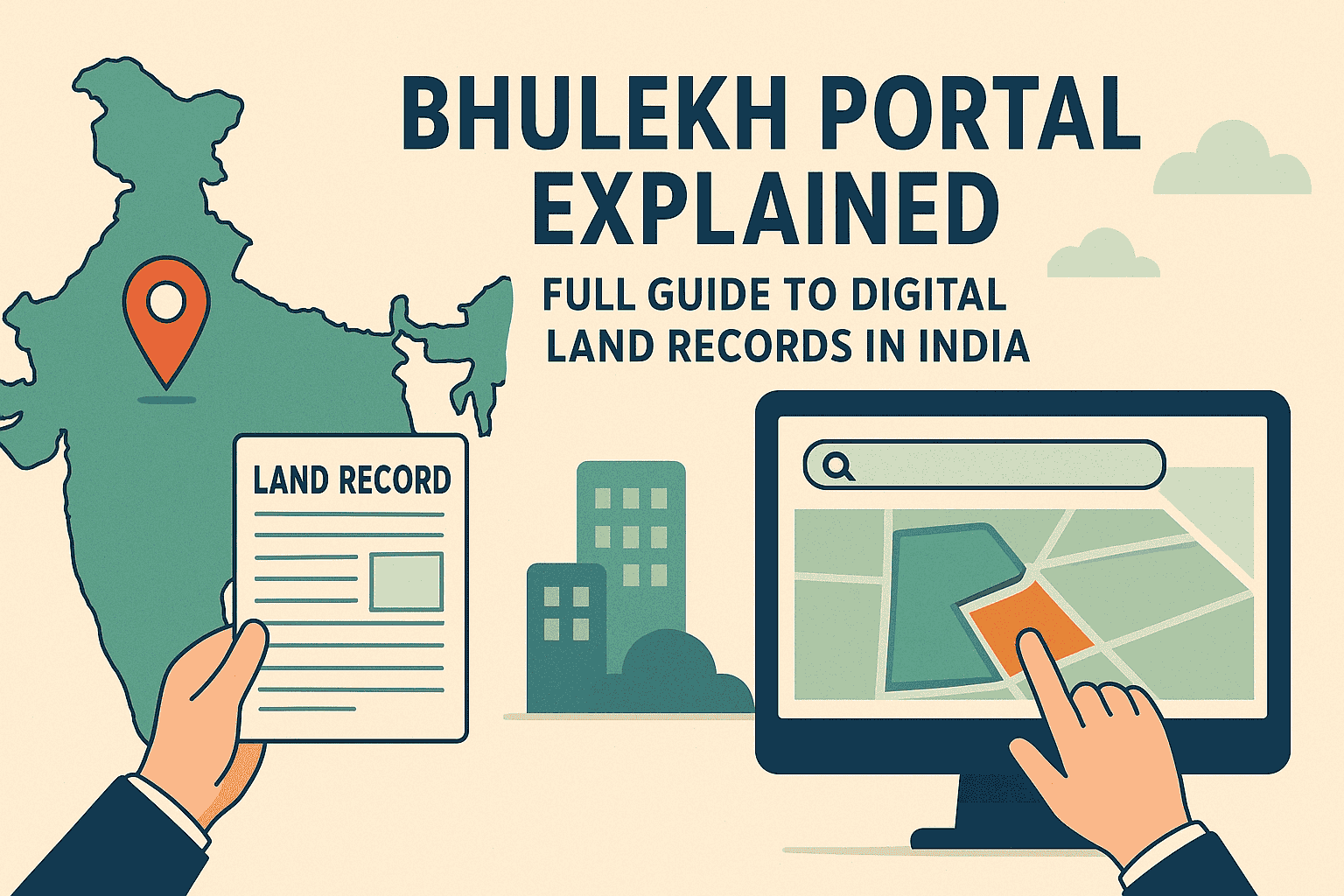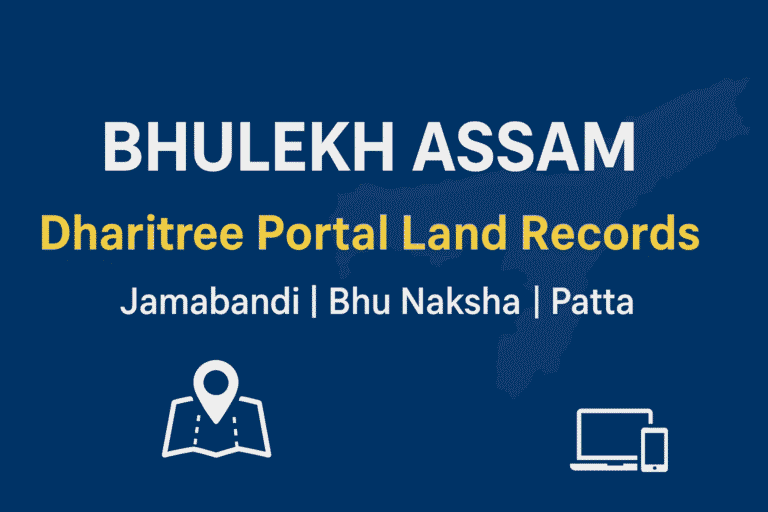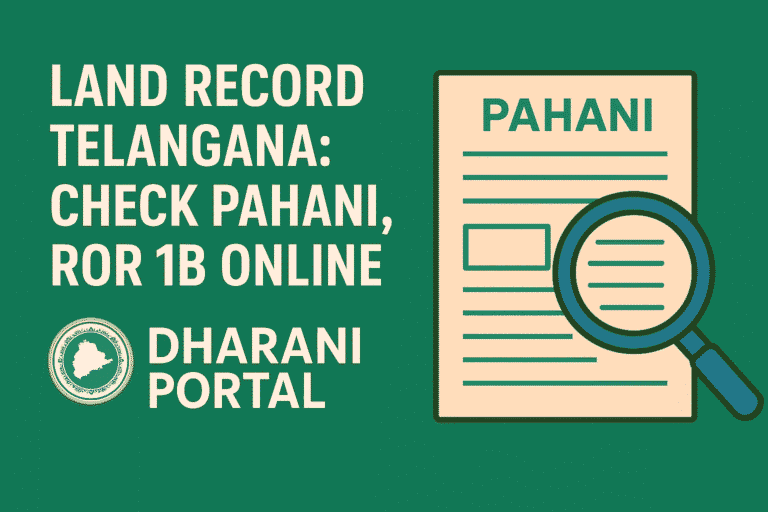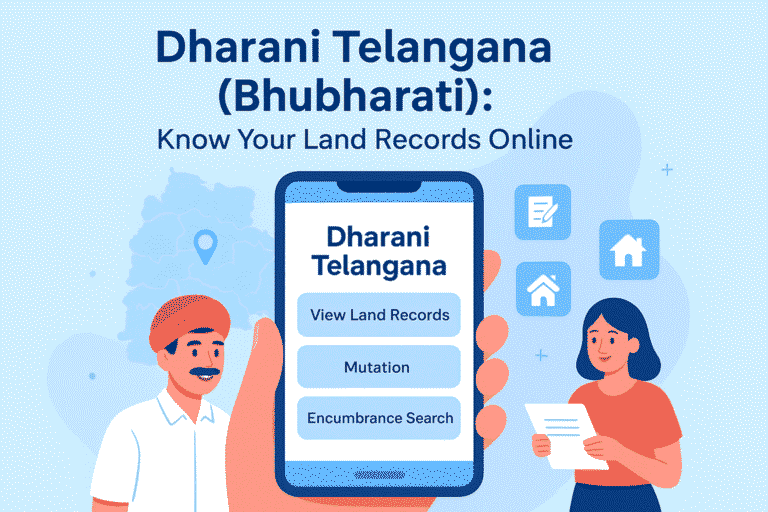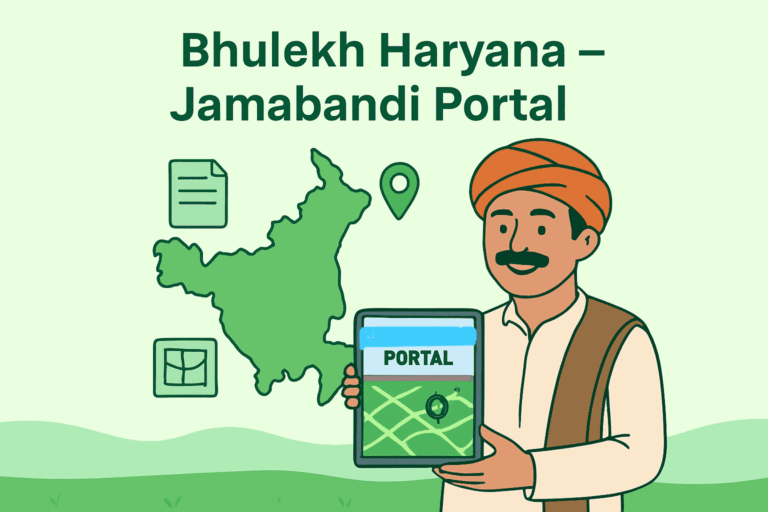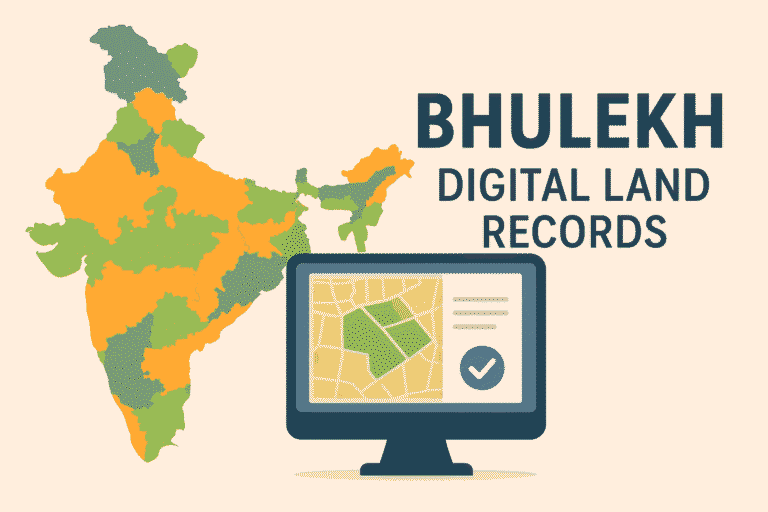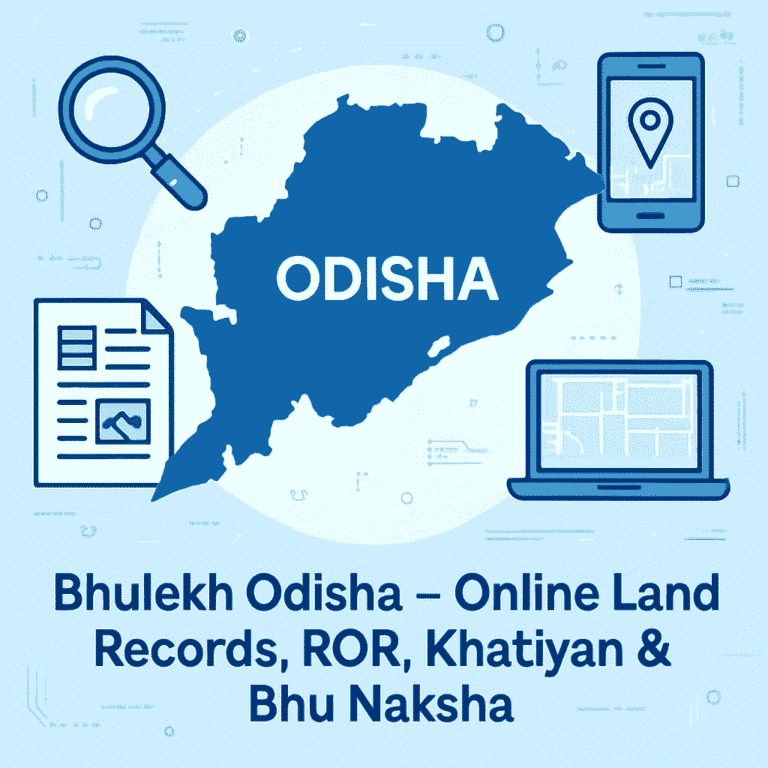Bhulekh Portal Explained: Full Guide To Digital Land Records in India
The Bhulekh Portal is India’s official digital platform for viewing land records (Bhu Abhilekh) online. Under the Digital India Land Records Modernization Programme (DILRMP), this system allows citizens to check Jamabandi, Khatauni, Khasra, ROR (Record of Rights), and Bhu Naksha online across all states and union territories.
What Is Bhulekh?
Bhulekh (भू-लेख) is a Hindi term meaning “land records.” It represents the government’s digital database of property ownership, plot boundaries, crop details, and mutation history.
The Bhulekh Portal—developed under the Digital India Land Records Modernisation Programme (DILRMP)—enables every Indian citizen to check, verify, and download their land information online, without visiting revenue offices.
Importance of Bhulekh Portal
- Promotes transparency in land dealings.
- Reduces corruption and middlemen.
- Provides legal clarity for ownership and mutation.
- Enables instant access to Khasra, Khatauni, and Jamabandi records.
- Supports farmers, landowners, and buyers in verifying land titles before transactions.
Major Services Available on Bhulekh Portal
Each state’s Bhulekh website offers slightly different options, but key services include:
| Service | Description |
| Jamabandi / Khatauni / ROR View | Check Record of Rights for any plot. |
| Khasra Details | View survey number, land type, and owner info. |
| Bhu Naksha | GIS-based digital map of your land parcel. |
| Mutation Status | Track pending or approved name transfer. |
| Land Ownership Verification | Confirm registered owner details online. |
| Certified Copy Download | Get official digital extracts for legal purposes. |
Features & Benefits of Bhulekh
- ✅ Online Accessibility: 24×7 access from anywhere.
- ✅ Transparency: Reduces fake entries and disputes.
- ✅ Fast Mutation Tracking: Real-time updates.
- ✅ Paperless Governance: Digital storage of millions of records.
- ✅ Free Access: No fees for basic searches.
- ✅ Legal Reference: Useful in property verification, loans, and court cases.
How to Use the Bhulekh Portal
- Visit your state’s Bhulekh website (see full list below).
- Choose View Jamabandi / Khatauni / ROR.
- Select District → Tehsil → Village.
- Enter your Khasra / Khata number or Owner’s Name.
- Click Search / View Details.
- Download or print your record if needed.
State-Wise Digital Land Records (Bhulekh) Portals in India
Benefits of Bhulekh Naksha for Landowners and Buyers
- Visual identification of plot boundaries.
- Prevents overlapping or encroachment disputes.
- Easy comparison of land area and survey data.
- Useful for real-estate due diligence.
How to Check Bhulekh Online (Example: UP Bhulekh Portal)
- Visit upbhulekh.gov.in.
- Click “View Imitation of Khatauni.”
- Choose District → Tehsil → Village.
- Search by Owner Name / Khasra Number / Gata Number.
- View and download your land record instantly.
How to Check Land Ownership Details on Bhulekh Portal Online
- Open your state Bhulekh site.
- Enter owner’s name or khasra details.
- The portal displays name of current owner, plot area, and mutation date.
Documents Required to Change Name in Bhulekh Land Records
| Document | Purpose |
| Sale Deed / Gift Deed / Will / Partition Deed | Proof of ownership transfer. |
| Mutation Application Form | To request name update. |
| Identity Proof (Aadhaar / PAN / Voter ID) | Verification of applicant. |
| Address Proof | Current residence of owner. |
| Death Certificate (if applicable) | For inheritance cases. |
| Affidavit & NOC | Legal confirmation. |
How to Change Name in Bhulekh Land Records Online
- Visit the Revenue Department / Bhulekh website.
- Login using Aadhaar / mobile number.
- Fill Mutation (Name Change) Form online.
- Upload supporting documents.
- Pay the required fee (if applicable).
- Track mutation status via the “Check Status” tab.
- Once approved, the new name appears in the Bhulekh record.
How to Change Name in Bhulekh (Offline Method)
- Visit your local Tehsil / Revenue Office.
- Collect and fill the Mutation Application Form.
- Attach sale deed, ID proof, and other documents.
- Submit to the Patwari or Tehsildar.
- After verification, records are updated offline.
How to Address Spelling Errors in Bhulekh Land Records Online
If your name or Khasra number is misspelled:
- Login to your state Bhulekh website.
- Navigate to “Correction / Grievance” section.
- Submit correction request with scanned documents.
- Track status until correction is approved.
List of Documents Required for Name/Spelling Correction
- Aadhar card
- Proof of correct name (PAN, Voter ID, etc.)
- Property ownership deed
- Application for correction
- Recent passport-size photo
Advantages of Bhulekh Records
- Instant verification for banks and buyers.
- Reduces land-related court cases.
- Helps in accurate tax and stamp duty calculation.
- Strengthens Digital India Mission.
Bhulekh: Important Terms
| Term | Meaning |
| Khasra Number | Plot or survey number. |
| Khatauni | Family register of land holdings. |
| Jamabandi | Record of Rights (ownership, cultivation, rent). |
| Mutation | Legal process of name transfer after sale/inheritance. |
| ROR | Record of Rights – comprehensive property details. |
Digital India Land Records Modernisation Programme (DILRMP)
Launched by the Government of India to:
- Integrate Bhulekh, Bhu-Naksha, and Registration Systems.
- Ensure 100 % digital land database.
- Enable Aadhaar-linked land ownership.
- Reduce fraud and duplication.
Conclusion
The Bhulekh Portal has transformed India’s land administration into a modern, transparent, and digital ecosystem.
It empowers millions of citizens with verified land ownership data, simplifies name-change and mutation processes, and integrates mapping through Bhu Naksha.
🌍 Bhulekh India – One Nation, One Digital Land Record Platform.
FAQs
A: Bhulekh (भूलेख) literally means land records. It’s the digital platform (state-wise) that stores ownership data, Khatauni/Khata, Khasra numbers, ROR (Record of Rights), mutation history and often cadastral maps (Bhu Naksha).
A: No. Bhulekh holds ownership/record data (RoR, Khata, Jamabandi). Bhu Naksha is the map/GIS view showing parcel boundaries and Khasra numbers. Many portals link both.
A: Typical services: view/download Jamabandi/RoR/Khatauni, search by owner/Khasra/plot, view Bhu Naksha maps, check mutation status, apply for corrections or mutations, and download certified extracts.
A: Visit your state Bhulekh site → choose District → Tehsil → Village → search by Owner Name / Khasra / Khata → view owner name, area and mutation entries → download if needed.
A: From the Bhulekh or linked Bhu Naksha page, select district/tehsil/village and enter plot/Khasra number. The map opens with zoom and download/print options (where available).
A: Online extracts are accepted as reference and for many administrative uses; for legal or sale registration you may need a certified/attested copy from the revenue office as per state rules.
A: Common documents: sale deed / gift deed / partition deed / succession certificate / will (as applicable), mutation application, identity proof (Aadhaar/PAN/Voter ID), address proof, death certificate (if inheritance), affidavit/NOC when needed.
A: Login to your state Bhulekh/mutation portal → fill the Mutation/Name-Change form → upload supporting documents (deed, ID, etc.) → pay fees if applicable → track application → record updated after verification.
A: Visit the local Tehsildar/Patwari/Revenue office → submit the mutation application and original documents → revenue officials verify on-site → records updated via the office workflow.
A: Use the portal’s Correction/Grievance function (if available) or submit an application at the revenue office with proof of correct spelling (Aadhaar, PAN). The office will verify and update the record.
A: Try alternate search modes (Khata/Khasra vs owner name). If data is still missing, visit the local revenue office—records might be pending digitization or under mutation.
A: Time varies by state and workload. After submission and verification it can take from a few weeks to several months. Use the portal’s application tracking to monitor progress.
A: Basic search is generally free. Some states may charge a nominal fee for certified extracts or printed attested copies — check your state portal for exact charges.
A: Yes — banks and buyers commonly use Bhulekh extracts for due diligence, though lenders often request certified/attested copies and title searches before loan approval.
A: Most state portals provide a “Mutation Status” or “Application Status” section—enter application or reference number to view. Otherwise visit Tehsil office.
A: First contact the local Patwari / Revenue Inspector / Tehsildar listed on the portal. If unresolved, escalate to the Dharani/Bhulekh grievance cell or state revenue department helpline.
A: Faster access, reduced fraud, easier transaction due diligence, simplified subsidy/benefit distribution, and improved planning through integrated maps and records.
A: Khasra (plot number), Khata/Khatauni (family holding register), Jamabandi (RoR), Mutation (name transfer), ROR (Record of Rights), Bhu Naksha (map).
A: Several states provide official mobile apps for Bhulekh/BhuNaksha. Check your state portal or app store for the official app (avoid third-party apps unless verified).
A: Collect portal extracts, visit local revenue/tehsil office for a field inspection, request rectification or survey if needed, and use legal remedies if the dispute persists.
A: Yes — use Owner Name or Village/Block filters. Results may be broader; refining with additional details (father/husband name, survey area) helps.
A: Not always. Updates depend on the local revenue office’s data entry and verification—digital update times vary by state and process.
A: Buyers can verify owner name, pending mutations, area, encumbrances and view the cadastral map—this reduces risk and supports title searches.
A: Bhulekh displays ownership data which is public record in India. However, portals follow government data policies; for privacy or misuse concerns contact the state revenue authority.
A: Link directly to the official state portal; do not republish full records without permission. When in doubt, use summarized guidance and link to the source.
Related Articles:
What is Bhulekh Khatauni? Complete Guide to Land Records in India
Bhulekh Andhra Pradesh: Meebhoomi Land Records Portal Explained
How to Check Land Records Online in India: Complete Guide
Land Records Information System in India | Digital Land Records
What is Bhulekh? A Complete Guide to India’s Digital Land Records System
Land Record Telangana: Check Pahani, ROR 1B Online on Dharani Portal
Land Record in Gujarat: How to Check 7/12 Utara & AnyROR Online
Understanding the Land Record Ecosystem of Uttar Pradesh
UP Bhulekh – Check Uttar Pradesh Land Records Online
J&K Land Records Information System- Check J&K Jamabandi Records
